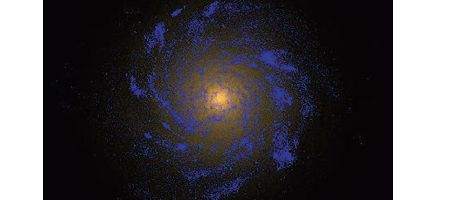Astrophysicists have for the first time created a computer model of galaxy formation that results in a spiral galaxy like our own.

After millions of processor-hours on a powerful supercomputer, researchers at the University of California, Santa Cruz, and the Institute for Theoretical Physics in Zurich have ‘created’ a galaxy called Eris.
“Previous efforts to form a massive disk galaxy like the Milky Way had failed, because the simulated galaxies ended up with huge central bulges compared to the size of the disk,” says graduate student Javiera Guedes.
Eris, however, is a massive spiral galaxy with a central ‘bar’ of bright stars and other structural properties similar to the Milky Way. Its brightness profile, bulge-to-disk ratio, stellar content and other key features are all within the range of observations of galaxies of the same type. “We dissected the galaxy in many different ways to confirm that it fits with observations,” Guedes said.
The results support the prevailing ‘cold dark matter’ theory, in which the evolution of structure in the universe is driven by the gravitational interactions of dark matter.
Gravity pulls together dark matter in ever-larger ‘clumps’, with ordinary matter falling in to produce the galaxies we see today, made of ordinary matter in the center of dark matter halos.
For the past 20 years, however, efforts to reproduce this process in computer simulations have failed to generate massive disk galaxies that look anything like the Milky Way, with its spiral arms in a large flat disk around a small central bulge made up of old stars.
“Star formation in real galaxies occurs in a clustered fashion, and to reproduce that out of a cosmological simulation is hard,” says professor Piero Madau.
“This is the first simulation that is able to resolve the high-density clouds of gas where star formation occurs, and the result is a Milky Way type of galaxy with a small bulge and a big disk. It shows that the cold dark matter scenario, where dark matter provides the scaffolding for galaxy formation, is able to generate realistic disk-dominated galaxies.”
The simulation has the highest resolution of any ever carried out, allowing for a more precise recipe for star formation.
In a low-resolution simulation, with gas densities averaged out over relatively large areas, the threshold density for star formation has to be set so low that stars tend to form in diffuse gas throughout the galaxy. In the Eris simulation, stars formed only in high-density regions, resulting in a more realistic distribution of stars.






